How to get kids to eat their holiday dinner
/Do your kids stick their nose up at their holiday meal? Here’s how to get your kids to actually eat more than bread and dessert.
Read More
Do your kids stick their nose up at their holiday meal? Here’s how to get your kids to actually eat more than bread and dessert.
Read MoreI’d like to preface this post by stressing that I realize that many busy parents get their groceries delivered. But since that takes planning and organization, I often end up lugging along my three kids. It’s never pretty.
Read MoreThis weekend is my firstborn son's 6th birthday. I'll spare you the sob story about how fast time goes (although it's very true!), but this particular birthday, I've been reflecting on how much we have both changed in those six short years. My oldest holds a special place in my heart not only for all the time that we had together just the two of us (sadly, my other two children never got all that one-on-one mommy time), but also because he was the reason I started this exact business. . .
Read MoreHealthy lunch box with sandwich and fresh vegetables, bottle of water and fruits on wooden background. From top view

If your summer is looking anything like mine, it’s filled with ice cream trucks, pizza nights, and treats at grandma’s house/the pool/the beach.My sneaky kids have gone so far as to befriend all the regulars on our beach who come with bags packed with Oreos. They then make their best puppy dog eyes and say, "I've never had an Oreo before." Works every weekend. Healthy summertime eating can sometimes feel like a lost cause. But these quick strategies steer 'em back on track and are so easy to implement. Follow them to make your whole family healthier right away.
1. Ask your child to wash a vegetable. Pull a step stool up to your sink, and give your child the “job” of rinsing off the vegetable that you’re serving. While a common goal for parents is to get their kids to actually eat more vegetables, all types of exposures count--even holding a veggie in their hand. Kids are natural explorers, so letting them grab hold of a veggie exposes their senses to something new in a completely non-intimidating way.
2. Eat dinner under your kitchen table. Or have your kids pick any place you can spread a picnic blanket: over the sandbox, atop their playground—anything works. Remember, this strategy isn’t for pizza night—serve something healthier that you want them to try. Changing up the location makes dinnertime less of chore for children than having to sit at the table, which translates into more of a chance that they’ll eat what’s in front of them.
3. Replace one of your go-to snacks with something homemade. 99 out of 100 times, the snacks you make yourself are healthier than anything you buy in a package. Instead of a store-brought granola bar, make these sweet spinach muffins or healthier blueberry muffins. Compared to packaged stuff, homemade snacks contain way fewer ingredients, an ingredient list you can pronounce, and no preservatives or artificial anything. That’s always a step in the right direction.
4. Put out a veggie tray after camp after the park. Add a mix of chopped veggies, like baby carrots, cucumbers, celery, pepper slices and a dip like hummus or ranch dressing. When kids are starving, they eat what’s in front of them. We do this about 30 minutes before dinnertime, and it works every time.
5. Count colors. Hang six pieces of construction paper on a wall or your door in these colors: green, orange, red, blue, yellow, purple. Tell your kids that your goal for the day is to eat as many of these colors as they can—whoever gets the most colors at the end of the week wins. And no, rainbow sprinkles don’t count :)

Children loves granola bars, but many brands you'll find on the shelves contain as much sugar as candy bar! But healthy packaged ones do exist, and they're a great snack to have on the road or on those days that you simply don´t have time to make your own. When I buy granola bars at the grocery store, I look for these numbers on the nutrition panel:Calories: around 150 Sugar: less than 10 gram Fiber: more than 3 grams
Here's a list of my favorite granola bars that I feel good about giving to my kids.
Made good granola bars. A great choice for the school or camp since they are nut free and free from the most common allergens. They come in 4 delicious flavors AND are made with vegetables. 1 bar has 7 grams of sugar and 90 calories which is a good snack size especially for toddlers and prek aged kids.
Junkless Chewy Granola Bar: All four flavors are made with fewer than 8 ingredients, which is a refreshing shift from the lines of unpronounceable ingredients often found in store-bought bars. Our two favorite flavors are Cinnamon Roll and Chocolate Chip.
Cascadian Farms Organic, Oatmeal raisin granola bar. Lower in sugar than their other flavors with only 7g of sugar and 80 calories, this is also a great option for toddlers.
Kashi Chewy Granola Bar in Trail Mix Flavor. This contains nuts, so while it might not be a good option for school or the park, it's a great snack for safe environments and contains a filling 3g fiber.
Kind Cinnamon Oat Bars. Not all Kind Bars are low in sugar and nut-free, but these are, which make them a great choice for school. With only 5g of sugar and 2g of fiber, these are a healthy and filling choice.
Lära bars. Made exclusively with dried fruit and nuts (so not school friendly), these are high in good fats and natural sugars from the fruit. I have my kids split a bar.
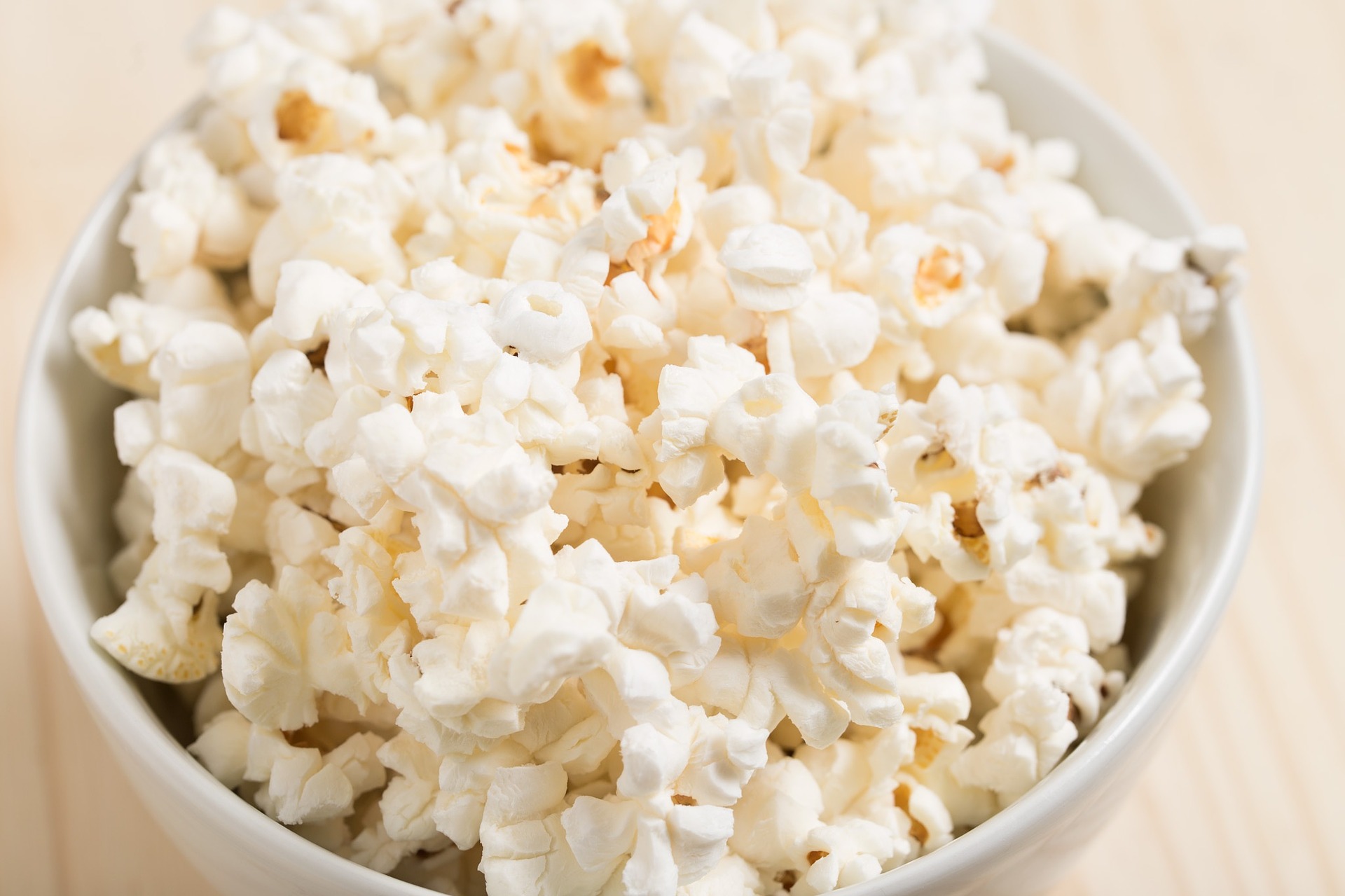
If time was never an issue and groceries magically appeared in our fridge, our kids would live on a diet of all homemade food all the time, but in reality, we do a mix of fresh foods, homemade snacks, and packaged ones. Here are our go-tos: 1. Organic popcorn
2. Sliced veggies like red peppers, cucumbers, and baby carrots with mini to-go hummus. These don't require refrigeration--perfect for on-the-go.
3. Homemade muffins, like these healthier blueberry muffins or kid-approved zucchini muffins.
4. Store brought granola bars: Check out our post on our favorite granola bars!
5. Apple slices with peanut butter or sunbutter
6. Applesauce pouches.Look for ones that have apples and water as the only ingredients and steer clear of ones that have fruit concentrates (another word for added sugar). We do Mott's Unsweetened Applesauce 
7. Yogurt sticks. We love the Siggis brand for being low in sugar and high in protein. The kids love these frozen.
8. A bowl of cereal with milk. Check our our post on our picks for the healthiest cereals
9. Mini whole wheat bagels with cream cheese or peanut butter
10. Cheese and crackers
11. String cheese. Our kids love the new character string cheese (and often fight over whether I should buy Spiderman or Paw Patrol!)
12. Whole fruit--apples, bananas, peaches, plums. They're so portable and can stay for a day or two in your purse or in your car.
13. Chopped fruit, like watermelon, cantaloupe, and raspberries and blueberries, which double as a hydration for hot summer days.
14.Harvest Snaps Pea Crisps. The kids LOVE these, and I love how they have natural protein from the peas.
15. Homemade trail mix. We make ours nut free with Cheerios, raisins, chocolate chips, and sunflower seeds.
Make boxed pancake mix healthier, colorful, and more FUN with these recipe-free ideas.
Read More
If your kids are like mine, they would eat cereal at every meal and snack of the day. But cereal can be one of those sneaky bad-for-you foods: The front of the box is packed with labels that make you think it's a good choice: "made with whole grains!" "now provides fiber!" "mother approved!" But front-of-box labeling is no indicator of health. To choose the healthiest cereal, you need to do your detective work on the back. Look for these 5 checkmarks before you toss that box in your cart.
What cereals are in your house that are both healthy and delicious?
A picky eater refuses food at the dinner table. (Lynn Koenig/Getty Images)

It seems to happen overnight: Your baby who once devoured baby food purees decides she only wants finger foods. Once babies begin to use their pinchers, they become more interested in perfecting picking up food from their trays, rather than being spoon fed by you. The good news is that you now have two free hands during mealtime (take this as your cue to eat!). But don't toss your freezer stash of pears, peas, and parsnips!
Whether your baby is moving on to the finger food stage or is ready for more than just single-ingredient fruit and veggies, these 10 puree-based food ideas (for baby AND you!) can help your baby transition to the next stage AND ensure your leftover stash doesn't go to waste.
 .
.
How do you use leftover baby food? Tell us your ideas!

There's nothing more refreshing after a day full of work, school, activities, homework, meetings, and playdates than sitting down and having dinner with my family. It's over food that we connect, talk, share and bond. That cherished family meal doesn't happen every night; for me and for most families, that would be impossible. The good news: Research shows that it only takes a minimum of 3 shared family meals per week (breakfast and lunch count, too!) to bring your family closer and make everyone healthier. How refreshing is that? For us, family meals happen mainly on the weekends when we have more time. I love to sit and chat after our plates are clean, and I always sip my wine slowly so my husband is forced to stay at the table with me! It's those meals that remind me of growing up; as a family, we always lingered around the dining table (and we still do when I visit home!). My plea to you is that you give your kids that same privilege—the payoffs of sharing a meal together are priceless, and they include .
10 Ways to Make Family Dinners Doable, Easy, and Fun!
1. Think about your week before your dive into the craziness of it all. Are any weeknights free of activities and doable for dinnertime together? Then set your goal to create a minimum of 3 family meals: Friday dinners, Sunday brunches, and Saturday lunch all count!
2. Plan a few meals in advance and add the ingredients to your weekly grocery list. Having everything on hand makes it much easier to whip something up without return trips to the grocery store or stressing out about what you're going to serve.
3. Turn the TV off and make it a rule that mealtime is free of all devices--your children (and you!) can survive 20 minutes without their phones or iPads!
4. Get the kids involved in cooking. Even babies as little as 1 or 2 years old can do certain tasks, such as peeling stickers off of fruit and veggies, washing them under running water, stirring, and pressing the buttons on the blender or food processor.
5. Keep meals simple. The goal is to spend quality time together--not to waste your whole night preparing something elaborate (and then feeling let down if your kids don't eat it.)
6. Create fun themes to get kids excited about mealtime: Think Macaroni Monday, Taco Tuesday, or Special Sunday Pancakes.
7. Let your child pick a recipe a week: Go to the grocery store together, gather the ingredients, and make it together. What they'll learn goes way beyond cooking: price, measurement, and more!
8. Make it enjoyable! Leave the serious discussions for later (read: no talk about Johnny's bad day at school), and let mealtime be a relaxing, calming, and comforting time.
9. Don't put pressure on the kids to eat what's on their plates. Instead, make the focus on the conversation and let the food be secondary. Nothing spoils dinner like constant pressure from parents telling their kids to take more bites.
10. Say grace and/or go around the table and have everyone say one thing they're happy about or thankful for.
What do you do to make family meals happen? Share your ideas--and inspire each other!

It's no secret that Americans consume way too much salt and sugar, and a new study in the journal Pediatrics shows that food companies may be prepping babies' and toddlers' tastebuds early to acquire these tastes. Many baby and toddler foods--even those marketed as "healthy" or "organic" contained a gross amount of excess sugar and sodium, according to researchers from the Centers for Disease Control and Prevention (CDC) . Almost half of fruit and grain based baby food contained added sugar, and foods made for toddlers—including vegetables, wheat or whole grain-based crackers, chips, sticks, or puffs—contained the sodium equivalent of plain potato chips.
We searched out the baby and toddler food offenders that pose as health foods so that you won't be duped.
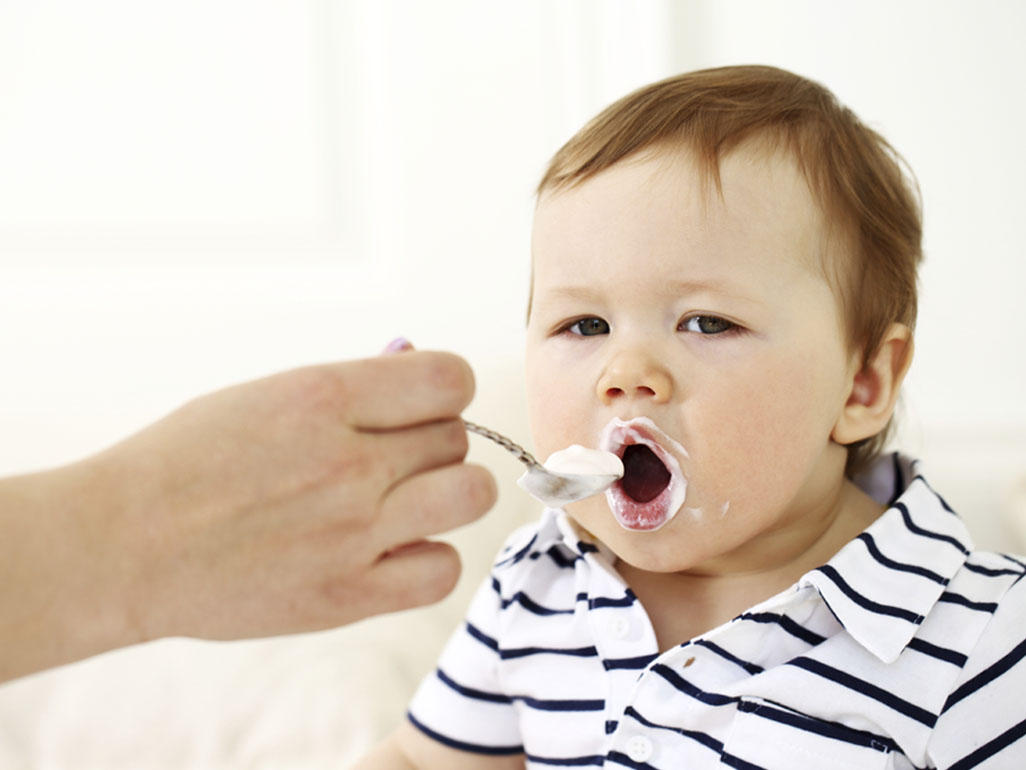
Yogurt is a healthy choice for toddlers, but most of the yogurts marketed for kids (yep, even the organic brands!) contain a whopping two teaspoons of excess sugar in their tiny containers—and that's not counting the natural sugar that's already present in dairy. If you're introducing yogurt to your baby for the first time, start with plain whole fat yogurt (yep, babies won't notice that it's missing sugar!). Or for kids, sweeten yogurt naturally by adding in a squirt of honey, maple syrup, or by stirring in fruit preserves or purees. For on-the-go options, look for yogurts that contain no artificial sweeteners and contain less than 2.5 grams of sugar per ounce, like the Siggi's brand.
2. VEGGIE PUFFS
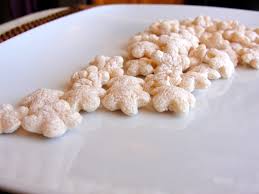
The one time I bought my toddler puffs was during an airport delay (desperate times, people!) and when I knew he'd be super squirmy on a flight and looking for snacks. But when I read the ingredients on the Sweet Potato Puffs I had just bought, I noticed that sweet potato wasn't actually an ingredient! While some puffs actually do contain sweet potato, broccoli, or kale "flour," these powders lack all the fibers of real veggies, and the nutrients from powdered vegetables may not be absorbed by the body the same way nutrients from whole vegetables are. Bottom line: Puffs should be served to kids in the same way you serve yourself refined carbohydrates: limited. For more nutritious snack choices, go for a no-sugar-added cereal, like cheerios.
3. CEREAL BARS & GRANOLA BARS

We get it: Kids love granola bars, and adults do too: They're easy, portable snacks that you can stick in your purse and pull out two weeks later if need be. But from a nutritional perspective, most bars contain nothing substantial but sugar--and most are so sickly sweet that they can prime your toddler's tastebuds to prefer overly sweet selections. In fact, the brands we researched contained THREE TYPES of processed sugar, unhealthy oils, and ingredient list thats way WAY longer than the front-of-box promise: "Made with real fruit and whole grains." There's nothing easier than making your own granola bars: We like to make a huge batch and freeze 'em, so they're just as convenient as anything processed, but way healthier. This five-ingredient recipe contains 0 added sugars and is made with nothing but whole grain goodness: In a bowl, combine 1.5 cups rolled oats, 1/2 cup unsweetened applesauce, 1 cup milk (any kind will do), 1 teaspoon cinnamon, and 3/4 cup raisins. Pour into parchment-lined loaf pan, and bake at 350 for 30 minutes until ingredients are set. Cool completely in the pan before cutting into squares.
4. BABY FOOD POUCHES MADE WITH SPINACH OR OTHER VEGGIES
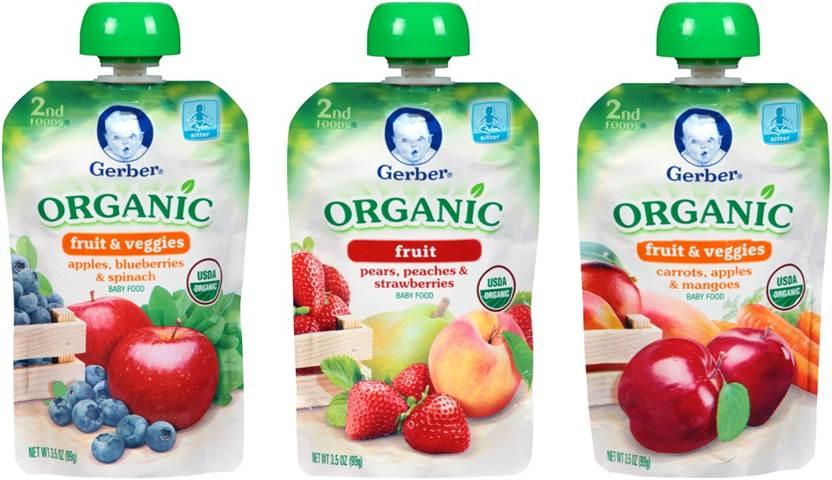
With names like "apple-spinach" and "zucchini-pear," they have to be good, right? While pouches serve their purpose (convenient, portable, etc.), relying on them as your tot's exclusive source of fruits and veggies can backfire. Check the ingredient list: Most contain "juice concentrates," which are a sneaky key word for sugar, and list the veggie as the very last ingredient, so there's not telling how much veggie they actually contain. Lastly, to maintain a shelf life, pouches are heated to super-hot temperatures, destroying the naturally-occuring nutrients that the fruits and veggies contain. (More on that here.) Consider making your own pouches, (we love the Infantino Squeeze Station) to control exactly what goes into them, and be sure to give your kids real fruits and veggies--you may be surprised to learn what they love!
5. TEETHING BISCUITS
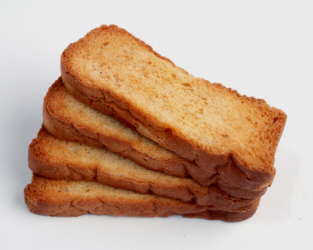
If they were labeled as what they really are ("Cookies for babies!"), no one would buy them. Hence the marketing ploy of calling them teething biscuits, which do little else to soothe teething any more so than than the calming effect of sticking a cookie in someones mouth. For serious teething relief that tastes good too, we swear by frozen bagels, frozen mango chunks or baby carrots in a mesh teether (like this here), or big thick carrots or frozen celery sticks for babies to gnaw on under adult supervision.

Welcome to the season of gifting, also known as the season of "What the heck do I give my kid's teachers?" Even more complicated is that most kids in daycare or preschool have like 10 teachers in their classroom (damn you, excellent teacher-studio ratio!) so buying gifts for every.single.one-of-em can add up to another month of tuition. You could do another mug (I'm sure they have NONE of those) or a tray of cookies that they'll secretly curse you for as they eat their feelings over their terribly behaved students (not yours, I'm sure). Or you could do this gift that was inspired by my own son's drop off and seeing kids walk into his classroom with barking sounding coughs and runny noses:
The Ultimate Flu and Cold Fighting Kit.
Its contents include things they'll actually need: items that keep them healthy when they're surrounded by dozens of germy toddlers. Some ideas for a kit can include:

We take elderberry syrup every morning for its potent cold and flu fighting powers. Dried elderberries are known to boost the immune system, and one study even found that elderberry syrup, taken daily, was as good at preventing the flu as the flu shot! That's some powerful stuff. Most naturopaths recommend taking 1 teaspoon a day for adults (or 1/2 teaspoon a day for kids), and then upping that to 2-3 times a day if you feel a cold coming on.
You could easily buy elderberry syrup at your local health food store or online (such as Gaia Herbs Black Elderberry Syrup, 5.4 Ounce
Elderberry syrup will last in the refrigerator for about 2 weeks, but I prefer to freeze in ice cube trays. Because it's a syrup, they don't freeze completely solid, so you can scoop out a half a cube each morning. I add them to my kids' smoothies or orange juice and I take mine straight from the spoon. For teachers, you could place syrup in small mason jars and include the downloadable file to include in your kit (scroll down to the end of the post to view).
Important Note: Because this homemade elderberry syrup contains honey, it should not be given to babies under age 1!
RECIPE: Homemade Elderberry Syrup Makes 4 Cups
Ingredients: 2/3 cup of dried elderberries. These are hard to find in store so we buy this brand on Amazon: Viva Labs Organic Elderberries, 1 lb Bag - The ULTIMATE Superfruit for Defense Syrups and Longevity Teas
3 1/2 cups water
1 cup honey such as Nature Nate's 100% Pure, Raw and Unfiltered Honey, 32 Ounce
1 teaspoon cinnamon
Directions:
Pour water, elderberries, and cinnamon into a saucepan and bring to a boil. (Do not add honey at this stage--it will burn!)
Once boiling, reduce heat and simmer for about 40 minutes until the liquid is reduced by half.
Remove from heat and let cool. Mash the berries using a spoon or potato masher, then pour elderberry juice through a fine mesh strainer into a bowl, pressing on the berries to get all the extra juice.
Whisk in honey until combined. Pour syrup into mason jars and store in the fridge for up to two weeks or in the freezer for up to 3 months.
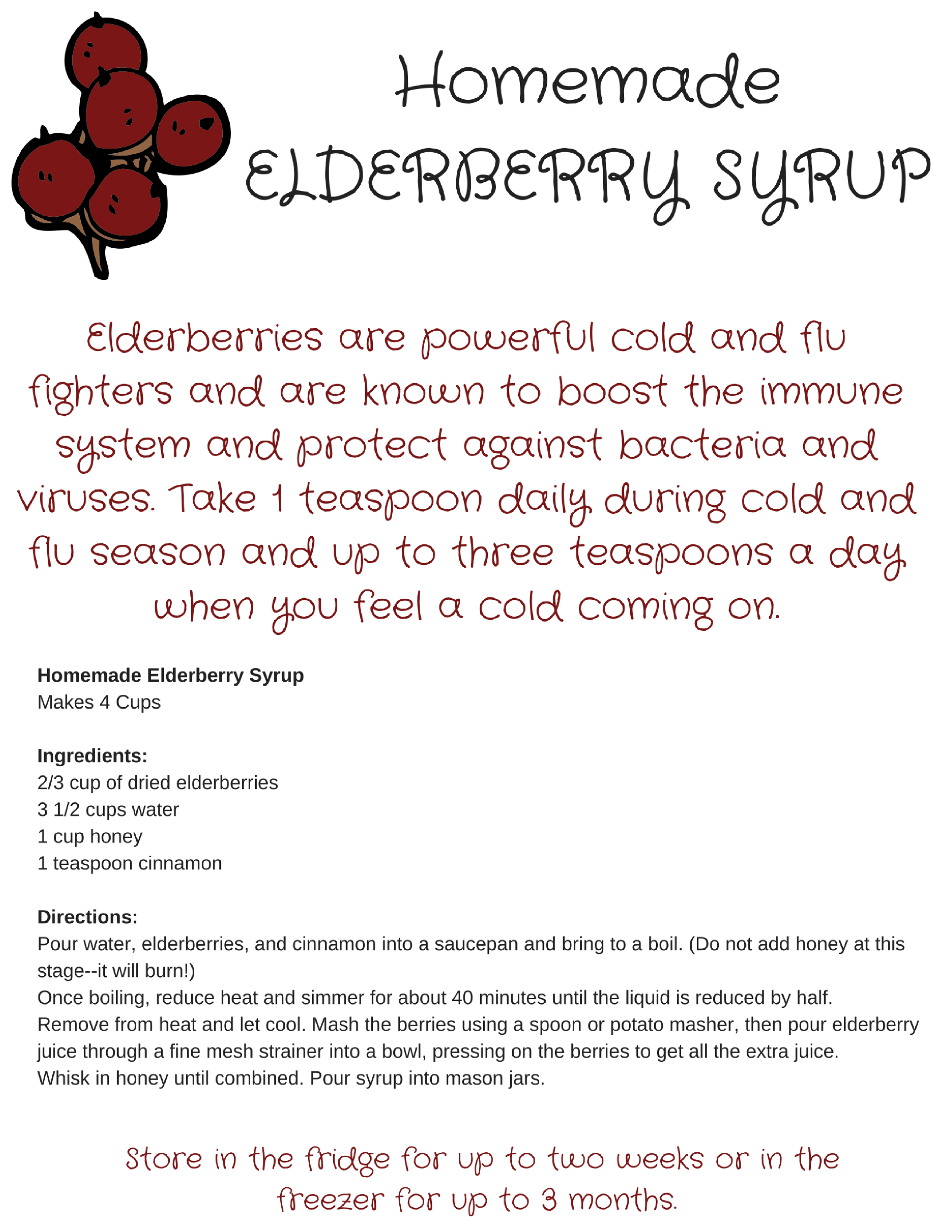

Finger foods are your baby's first step in the transition to table food—and let's face it: Without the need to spoon feed, you now have two hands free during meal time (score!). But many packaged finger foods that are made specifically for this toddler stage are loaded with salt and sugar, according to a recent study. Ugh! Step away from the teething crackers and pick up these nutrient- and flavor-packed choices:
FRUIT AND VEGGIES! {veggies} - steamed cut up carrots - frozen mixed veggies, defrosted - steamed chopped broccoli or cauliflower - cut cooked green beans - diced cooked squash or sweet potato - diced steamed zucchini or summer squash
{fruit} - halved blueberries - avocado chunks rolled in wheat germ or ground flaxseed for easier pickup - banana slices rolled in wheat germ or ground flaxseed for easier pickup - small chunks of peaches, plums or mango - small dices of melon - steamed apple or pear dices
HIGH PROTEIN OPTIONS {beans (when buying canned, go for organic or low sodium, and always rinse)} - small white beans - cooked lentils - black beans - small pink beans {meat, fish, and eggs} -scrambled eggs cooked in butter - flaked salmon - shredded chicken - cut up meatballs {misc.} - tofu cubes - shredded cheese or cheese cubes
HEALTHY CARBOHYDRATES - homemade muffins, cut up - frozen whole wheat bagel (great for teething!) - cheerios or other whole grain no-sugar-added cereal - cooked whole grain pasta (top with tomato sauce or a veggie puree) - plain waffles or pancakes, cut up

One of the most common questions I get asked about baby food is this: “Why should I make my own? Isn’t jarred food the same thing?” The truth is that while the ingredients might read the same as what you’d use to make at home (like carrots and water, for example), there are many major differences that aren’t always so noticeable. These five truths about jarred baby food are truly shocking.
The bottom line is that when you buy food from a store shelf, it’s impossible to know everything that goes into it, and making your own baby food (and using organic fruits and veggies when available), is THE BEST WAY TO know exactly what’s going into your baby’s belly.
Peasful Kitchen was started as a social place for like minded parents to connect, learn, and enjoy making food for their families. We have since grown from a baby food company to a complete website that covers every stage of a families growth — from freezer meals for expectant moms, to baby and toddler food, to family dinners that bring smiles ( and sanity!) to your table.
Whether you’re a new mom who wants to serve your baby real food from the start, or you’re a veteran parent who wants to put more nutritious meals on the table, we can help you make dinnertime more do-able. Join us, and experience the confidence and pride that comes with taking the step to make your family healthier and happier.
CATEGORIES
We are constantly working to raise the bar on our services. If you have any questions or concerns about your experience, please let us know.
Nicole
nicole@peasfulkitchen.com